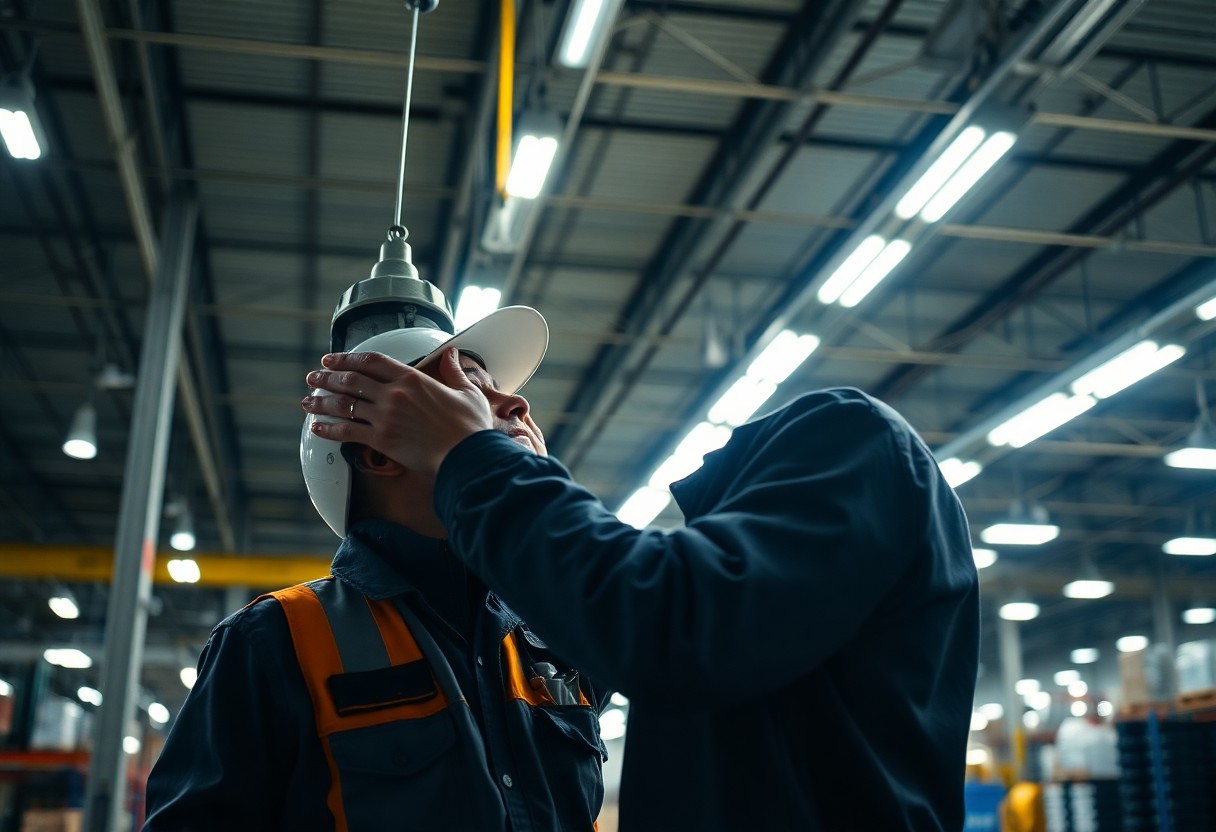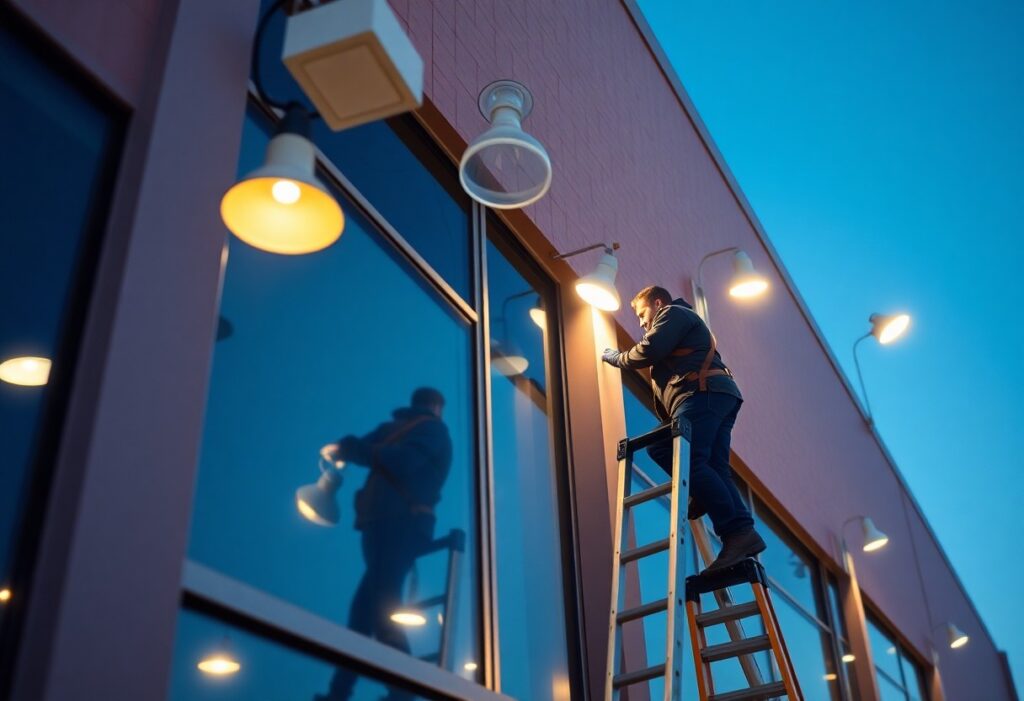Just like any other aspect of your facility, effective lighting maintenance plays a vital role in ensuring smooth operations. Poorly maintained lighting can lead to unexpected downtime and expensive repairs, impacting both productivity and safety. By prioritizing regular inspections and timely replacements, you can safeguard your investment and maintain optimal working conditions. This guide will help you understand the importance of lighting upkeep and provide actionable tips for maximizing the lifespan of your lighting systems.
Key Takeaways:
- Regular lighting maintenance extends the lifespan of fixtures and reduces the frequency of service interruptions.
- Proactively addressing minor issues can help avoid more significant problems and costly repairs later on.
- Implementing a scheduled maintenance plan ensures optimal performance and energy efficiency of lighting systems.
Understanding the Importance of Lighting Maintenance
While it may seem like just a minor detail, the quality and reliability of your lighting can significantly affect your business operations. Well-maintained lighting promotes productivity and enhances employee morale, while poor lighting can lead to errors, accidents, and decreased efficiency. You want your work environment to be safe and inviting, and the first step towards achieving that is through effective lighting maintenance.
The Impact of Lighting on Business Operations
Understanding how lighting influences the flow of your business is necessary. Good lighting can boost productivity, enhance customer experience, and ensure a safe and pleasant atmosphere. Conversely, inadequate lighting can cause distractions, fatigue, and even safety hazards, ultimately affecting your bottom line.
Cost Implications of Poor Lighting Maintenance
Behind every flickering bulb or dimmed fixture lies a potential financial burden that can catch you off guard. Neglecting lighting maintenance leads to higher energy costs due to inefficient fixtures and increased likelihood of unexpected replacements, amplifying your operational expenses over time.
To minimize these risks, establish a regular maintenance schedule. Ignoring small issues can turn them into significant problems, forcing you to spend more on repairs or replacements than you would on routine upkeep. By addressing lighting needs proactively, you not only extend the life of your fixtures but also ensure a consistently bright and functional environment for both employees and customers.
Regulatory Compliance and Safety Standards
About ensuring your lighting systems meet regulatory compliance and safety standards, it’s necessary to stay informed and proactive. Meeting these requirements not only protects your business from potential fines but also provides a safer working environment for your employees and customers.
Indeed, adhering to the standards laid out by organizations like OSHA can require regular reviews of your lighting conditions and prompt maintenance activities. Failure to comply can lead to inspections, fines, or costly legal implications. Ensuring your lighting systems are well-maintained not only helps you stay compliant but creates a safe, comfortable atmosphere in which your business can thrive.
Types of Lighting Systems
Even though lighting systems vary widely, understanding the types available can significantly impact your maintenance strategies and overall operational costs. Here’s a breakdown of the most common types of lighting systems:
| Type of Lighting | Characteristics |
|---|---|
| LED Lighting | Energy-efficient, long lifespan, low heat emission |
| Fluorescent Lighting | Cost-effective, good color rendering, requires ballast |
| High-Intensity Discharge (HID) Lighting | High brightness, great for outdoor and large spaces |
| Smart Lighting Solutions | Connected systems, adaptive, energy-saving features |
| Incandescent Lighting | Traditional option, warm quality, low efficiency |
The Commercial Lighting Maintenance Advice & Tips provided can guide you in your choice of lighting system for optimal performance. The following subsections explore each lighting type in more detail.
LED Lighting
Lighting has shifted towards LED systems due to their energy efficiency and prolonged lifespan. By using LED lighting, you can significantly reduce your energy bills while enjoying bright, high-quality illumination. Their low heat emissions also enhance safety and extend the durability of your fixtures.
Fluorescent Lighting
To maximize effectiveness, you can implement fluorescent lighting in various settings. This type of lighting is highly efficient and is often used in commercial spaces, providing a cooler light than incandescent bulbs. Their design includes a ballast, which regulates the current to maintain stability.
Also, fluorescent lights typically have a longer lifespan compared to traditional incandescent bulbs. However, they can be less efficient when it comes to color accuracy and may emit a flicker, which could be uncomfortable for some individuals. Regular maintenance can help you avoid these potential issues and keep your lighting functional.
High-Intensity Discharge (HID) Lighting
Against the backdrop of various options, HID lighting stands out with its exceptionally high brightness levels. Commonly used in outdoor settings like stadiums and parking lots, these lights deliver powerful illumination while being energy-efficient, ideal for large areas.
Lighting with HID technology can significantly reduce energy consumption when properly maintained. However, it’s crucial to schedule regular upkeep, as HID lamps can require more frequent replacements compared to other lighting forms. Managing this type of lighting through maintenance can prevent unexpected outages and costly repairs.
Smart Lighting Solutions
Among the latest technological advancements, smart lighting solutions offer numerous advantages. These systems can be controlled remotely, allowing you to adjust brightness and settings from any location, enhancing efficiency and convenience.
Systems that utilize smart lighting features provide flexibility in energy management, enabling you to set schedules or automate them based on occupancy. Regular maintenance ensures these systems operate smoothly, avoiding unnecessary downtime and enhancing operational efficiency throughout your facilities.
Common Lighting Issues and Their Causes
Despite your best efforts in maintaining your lighting system, common issues can still arise. Understanding these problems, their causes, and how they affect your operations is imperative for avoiding downtime and costly repairs.
Flickering or Dimming Lights
An intermittent flickering or dimming of lights can often indicate issues with your electrical connections or voltage fluctuations. This not only disrupts ambiance but may also lead to further damage if not addressed promptly.
Burned-Out Bulbs
The most frequent lighting issue you may encounter is burned-out bulbs, which can happen due to age, frequent switching on and off, or poor-quality replacements.
Considering that light bulbs have a finite lifespan, it’s important to keep track of their usage. Over time, factors such as excessive heat, vibrations, and even using bulbs not suited for their fixtures can accelerate burnout. Regularly checking and replacing them before they fail can save you from unexpected outages.
Inefficient Energy Use
Between rising energy costs and environmental concerns, inefficient energy use in lighting can significantly impact your bottom line.
Their effectiveness can be compromised by outdated systems or improper bulb choices. By evaluating your existing fixtures and opting for energy-efficient options, like LED lighting, you can not only reduce energy consumption but also contribute to a more sustainable environment.
Electrical Failures
Among the more serious lighting issues are electrical failures, which can stem from faulty wiring, overloaded circuits, or inadequate maintenance.
Lights can flicker or fail altogether due to disruptions in the electrical supply. Inconsistent performance may also lead to safety hazards or equipment damage. Performing regular inspections and hiring licensed professionals for maintenance can help prevent these electrical failures and ensure a reliable lighting system for your space.

Developing a Lighting Maintenance Plan
Once again, reviewing and enhancing your lighting maintenance plan is necessary for ensuring the longevity and efficiency of your lighting systems. A well-structured maintenance plan includes regular inspections, timely scheduling of maintenance tasks, identifying performance indicators, and incorporating technology for constant monitoring. This proactive approach can significantly reduce downtime and expensive repairs, ultimately saving you time and resources.
Conducting Regular Inspections
Inspections are vital to identifying potential issues before they escalate into significant problems. By routinely checking your lighting fixtures and systems, you can detect burnt-out bulbs, damaged wiring, or malfunctioning sensors. Implementing an inspection checklist can streamline this process and ensure that no element is overlooked, ultimately enhancing the performance of your lighting systems.
Setting a Maintenance Schedule
Plan your maintenance schedule with intentionality, ensuring that tasks are performed consistently and thoroughly. Prioritizing regular maintenance intervals allows you to address minor concerns before they evolve into major issues, contributing to greater efficiency and longer equipment life.
Consequently, a well-established maintenance schedule should align with factors such as usage patterns, seasonal changes, and historical data on equipment performance. By setting frequency for inspections and tasks—ranging from monthly to annually—you can optimize your lighting systems while minimizing unplanned disruptions and costs.
Identifying Key Performance Indicators (KPIs)
KPIs serve as benchmarks to gauge the effectiveness of your lighting systems and maintenance strategies. By determining relevant KPIs such as energy consumption, bulb lifespan, and maintenance costs, you can gain valuable insights into your lighting’s performance over time.
Regularly reviewing these indicators enables you to adjust your maintenance plan dynamically, ensuring that your system remains efficient and cost-effective. Establishing KPIs helps highlight areas needing improvement and assists in better allocation of resources towards more impactful maintenance activities.
Utilizing Technology for Monitoring
KPIs can be enhanced by utilizing technology for monitoring your lighting systems. Automation and smart technologies allow for real-time data tracking, helping you stay informed about system performance and any irregularities that may arise.
Utilizing advanced monitoring tools can provide insights that allow for timely interventions, preventing situations that may lead to costly repairs or increased downtime. By incorporating technology into your maintenance plan, you increase efficiency and improve overall reliability in your lighting systems.
Best Practices for Effective Lighting Maintenance
For anyone managing a facility, effective lighting maintenance is vital to uphold operational efficiency and minimize unexpected downtime. Regular maintenance helps you avoid costly repairs down the road and can even improve energy efficiency. To discover more about the advantages, check out this article on 4 Benefits of Getting Regularly Scheduled Lighting Maintenance.
Cleaning and Replacing Bulbs
Bulbs are vital components of your lighting system, and dirt and grime can severely impact their performance. Regularly cleaning fixtures and replacing burnt-out or dim bulbs ensures optimal illumination and energy efficiency, extending the lifespan of your lighting system.
Upgrading to Energy-Efficient Solutions
Along with maintenance, upgrading to energy-efficient solutions can significantly lower your energy costs. Modern LED lights consume less power and have a longer lifespan, providing a sustainable alternative to traditional lighting options.
Considering the long-term benefits, investing in energy-efficient lighting not only reduces your operational expenses but also decreases your carbon footprint. You will find that these upgrades often pay for themselves over time through the savings they generate.
Training Staff on Basic Maintenance
Solutions for effective lighting maintenance can also include training your staff on basic maintenance tasks. This proactive approach empowers your team to identify and report issues before they escalate into substantial problems.
Hence, equipping your employees with knowledge about basic maintenance can foster a culture of responsibility and ensure that your lighting system remains in optimal condition. Regular training sessions can be incorporated into staff development to keep everyone informed about best practices.
Engaging Professional Services
Below, engaging professional services can be an integral part of your lighting maintenance plan. A qualified technician is equipped to handle complex issues that your in-house team might not be able to address effectively.
But relying solely on in-house effort may not be sufficient for sophisticated lighting systems. Professional services can conduct comprehensive inspections and perform specialized maintenance, ensuring that your lighting operates safely and efficiently for years to come.
Case Studies: Successful Lighting Maintenance Strategies
After conducting thorough research and analyzing various industries, you can see distinct patterns in successful lighting maintenance strategies that have led to enhanced performance and reduced costs. Below are some enlightening case studies that demonstrate the advantageous impact of effective lighting maintenance.
- Retail Sector Success: A large retail chain reported a 20% reduction in energy costs after implementing a comprehensive lighting maintenance program that included LED retrofitting and regular bulb replacements.
- Manufacturing Efficiency: An automotive manufacturer invested in smart lighting controls and saved approximately $50,000 annually in energy costs, while improving the overall visibility for workers.
- Healthcare Facility Outcome: A hospital adopted an ongoing lighting inspection regimen, resulting in a significant decrease in work order requests by 30%, minimizing downtime for repairs.
Retail Sector Examples
One prominent retail chain revamped its lighting maintenance strategy, leading to an impressive 25% increase in customer satisfaction. By regularly updating fixtures and ensuring consistent light quality, they created a more inviting shopping environment. This attention to detail reflected positively on their bottom line.
Industrial Application Case Studies
Behind the industrial sector, a series of lighting maintenance efforts revealed substantial gains. A logistics company implemented an automated monitoring system for their lighting, resulting in a 40% reduction in outages, saving over $70,000 in emergency repair costs.
- Logistics Firm: By automating their lighting controls, an organization decreased its downtime from lighting failures by 50%, ensuring operations were uninterrupted.
- Food Production Facility: Regular inspections and maintenance reduced lighting failures by 60%, equating to annual savings of $80,000 on repair and downtime costs.
- Warehouse Efficiency: A warehouse saw a 30% increase in productivity after switching to LED lights and implementing a structured maintenance schedule, providing better visibility for staff.
Office Environment Insights
Across many office environments, illuminating spaces properly not only enhances employee morale but also leads to improved productivity. Studies show that firms investing in effective lighting upkeep report notable increases in work output.
Educational Institutions’ Approaches
At various educational institutions, consistency in lighting maintenance contributes to optimal learning conditions. Schools that have dedicated teams focusing on light quality frequently witness heightened student engagement and academic performance.
Due to the varying needs within educational settings, many institutions have opted for customized lighting solutions. These tailored strategies have led to decreased operational costs and improved energy efficiency, paving the way for sustainable practices moving forward.
Conclusion
Following this, you can significantly minimize downtime and reduce the risk of costly repairs by prioritizing lighting maintenance in your facility. Establishing a routine inspection and maintenance schedule not only enhances the longevity of your lighting systems but also improves workplace safety and productivity. To ensure you’re on the right track, consider implementing the 5 Best Practices for Industrial Lighting Maintenance to streamline your processes and keep your operations running smoothly.
Q: Why is regular lighting maintenance important for businesses?
A: Regular lighting maintenance is vital for businesses as it ensures optimal performance and longevity of lighting systems. Consistent inspections and upkeep help identify potential issues before they escalate, reducing the risk of unexpected failures. When lighting systems are well-maintained, they operate more efficiently, which can lower energy costs and enhance the work environment for employees, ultimately leading to increased productivity.
Q: What are some common signs that a lighting system needs maintenance?
A: Several signs indicate that a lighting system may require maintenance. Flickering or dimming lights can suggest that bulbs are nearing the end of their life or that there are issues with connections. Frequent bulb burn-outs can also be a warning sign of underlying electrical problems. If certain areas are consistently darker than others, this may indicate the need for cleaning or replacement of fixtures to ensure proper lighting levels. Addressing these issues early on can prevent sudden breakdowns and associated repair costs.
Q: How can businesses implement an effective lighting maintenance schedule?
A: To establish an effective lighting maintenance schedule, businesses should first assess their lighting systems and identify the type and number of fixtures in use. Next, create a routine inspection plan that includes regular checks on bulb functionality, fixture cleanliness, and electrical connections. Depending on the usage and environment, these checks can be scheduled monthly, quarterly, or biannually. Additionally, documenting maintenance activities and any repairs performed can provide valuable insights for future upkeep and help in budgeting for replacements and upgrades.



